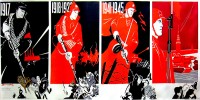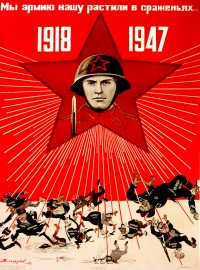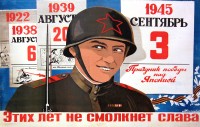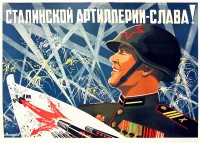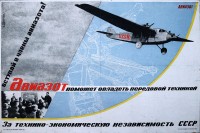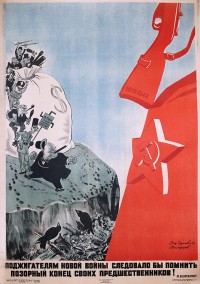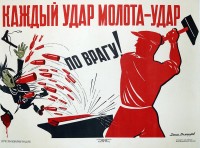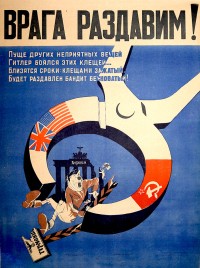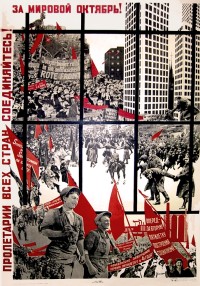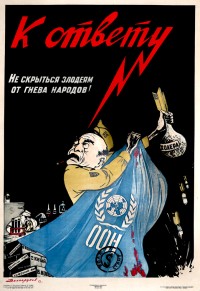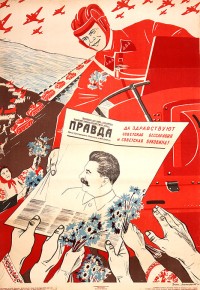Dolgorukov, Nikolai Andreevich
Born 1902, Ekaterinburg, Russian Empire; died 1980, Moscow, USSR
In 1928, Nikolai Andreevich Dolgorukov moved from his native Ekaterinburg to Moscow to attend VKhUTEIN (Higher State Artistic and Technical Institute). After that organization dissolved in 1930, Dolgorukov continued his studies at the Moscow Polygraphic Institute under the tutelage of artists Lev Bruni and Dimitri Moor. Dolgorukov's training was in illustrated political satire as well as in poster design, and each area became the main focus of his long career. After graduation, he collaborated with fellow poster artist Viktor Deni. The duo went on to design a host of iconic Soviet posters from the 1930s to the 1940s. Dolgorukov also created illustrations for prominent newspapers such as: Krasnaia Zvezda [Red Star] (1933), Pravda [Truth], (1934), Izvestia [News] (1949), and for journals including Proektor [Projector] (1932-1935), Sovetskii Soldat [Soviet Soldier] (1941) and Iskra [Spark] (1942). Dolgorukov produced a variety of well-known posters, such as Under the Banner of Lenin toward the Formation of a Classless Society (1932) and Five-Year Plan (co-authored with Deni in 1933). During World War II, Dolgorukov remained active as a graphic designer and a cartoonist producing a myriad of war-time posters including, We'll Sweep Away the Fascist Barbarians (1941) and The Enemy Will Not Have Mercy! He contributed two poster designs to the Soviet telegraph TASS Studio between the autumn of 1942 and the autumn of 1943.
At the 1948 International Poster Exhibition in Vienna, Dolgorukov was awarded the 1st prize for two of his posters: Everyone Votes For the Elections to the Supreme Council of Turkmen SSR (1947) and The Warmongers Must Remember the Ignominious Fate of their Predecessors (co-authored with Boris Efimov in 1948). Dolgorukov was awarded the title Honored Worker of Arts of the Russian Soviet Federated Socialist Republic in 1968 and in 1969, he received a gold medal from the Soviet Foundation for Peace. He actively exhibited abroad: Danzig (1930); Brussels (1932); Chicago, Madrid, and Paris (1933); London (1943), Wroclaw (1953); Berlin (1960), Warsaw (1962). He had his own retrospective show in Prague in 1969.
Nikolai Dolgorukov published articles and essays on poster production in Pravda and Izvestia and authored a number of books, including Stranitsy zhizni [Pages of Life] (1963) and Vstrechi i vpechatlenia [Encounters and Impressions] (1963).
Fuentes
Zegers, P., et al. (2011). Windows on the war: Soviet TASS posters at home and abroad, 1941-1945. Chicago: Art Institute of Chicago. (pp. 34, 37, 382)
Onufrieva, S. A. (1963) Nikolai Andreevich Dolgorukov Stanitsy Zhizni. Leningrad: Khudozhnik RSFSR. (book on the life and career of Dolgorukov)
Butnik-Siverskii, B. S. (1960). Sovetskii plakat epokhi grazhdanskoi voiny, 1918-1921. Moskva: Izd-vo Vsesoiuznoi knizhnei palaty. (pp. 35, 37, 41)
Baburina, N. I. (1988). The Soviet Political Poster, 1917-1980. New York: Penguin. (bio, artist)
![PP 066: El Ejército Rojo -- ¡El orgullo de la nación!
Defendemos la paz y defendemos…
Pero no tememos a las amenazas… [el texto que sigue es ilegible]](https://www.posterplakat.com/thumbs/the-collection/posters/pp-066/pp066-200x134.jpg)
![PP 124: [Estados Unidos] Va demasiado lejos – ¡su cabeza se romperá!](https://www.posterplakat.com/thumbs/the-collection/posters/pp-124/pp124-200x68.jpg)
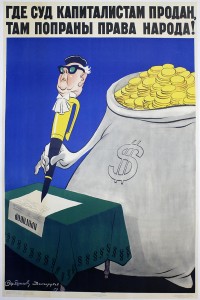
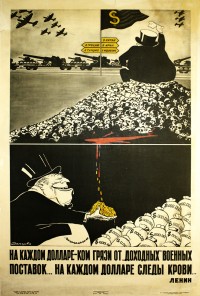
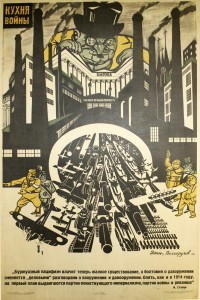
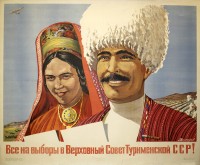
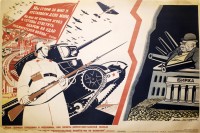
![PP 540: ¡Vivan los orgullosos halcones de nuestra patria, oficiales de Stalin, valientes pilotos, que no conocen barrera alguna a la hora de cumplir con el objetivo establecido!
¡Nuestros más cordiales saludos a las heroicas hijas del pueblo soviético –
¡Valentina GRIZODUBOVA, Polina OSIPENKO y Marina RASKOVA!”
[Traducción parcial]](https://www.posterplakat.com/thumbs/the-collection/posters/pp-540/pp540-200x142.jpg)
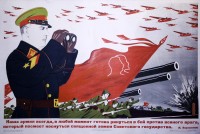
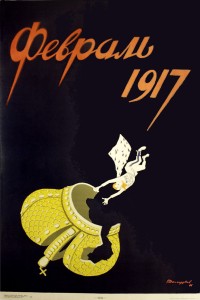
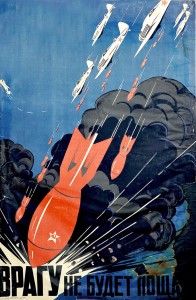
![PP 653: Results of the First Five-Year Plan.
[Partial translation]](https://www.posterplakat.com/thumbs/the-collection/posters/pp-653/pp653-200x267.jpg)
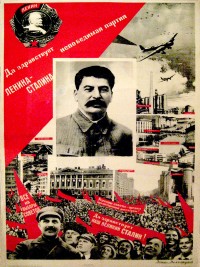
![PP 741: In February of 1940 the pilots Sokolov and Kozachenko were flying back to their airfield after an air fight.
It was clear above the snowy clouds. Suddenly Sokolov sighted a group of Belofinn planes in a formation of twelve “Volkers”.
The force of the enemy exceeded ours by six times.
[Partial translation]](https://www.posterplakat.com/thumbs/the-collection/posters/pp-741/pp741-108x300.jpg)
